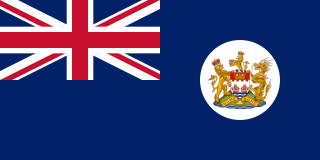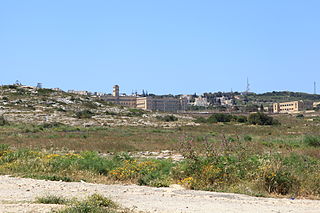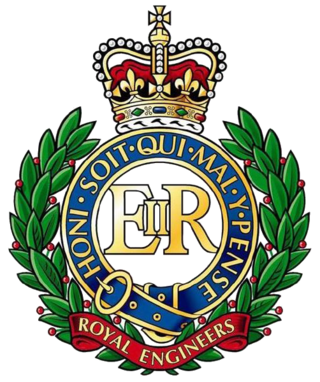
The Royal Regiment of Artillery, commonly referred to as the Royal Artillery (RA) and colloquially known as "The Gunners", is one of two regiments that make up the artillery arm of the British Army. The Royal Regiment of Artillery comprises thirteen Regular Army regiments, the King's Troop Royal Horse Artillery and five Army Reserve regiments.

British Forces Overseas Hong Kong comprised the elements of the British Army, Royal Navy and Royal Air Force stationed in British Hong Kong. The Governor of Hong Kong also assumed the position of the commander-in-chief of the forces and the Commander British Forces in Hong Kong took charge of the daily deployment of the troops. Much of the British military left prior to the handover of Hong Kong to China in 1997. The present article focuses mainly on the British garrison in Hong Kong in the post Second World War era. For more information concerning the British garrison during the Second World War and earlier, see the Battle of Hong Kong.

Pembroke is a town in the Northern Region of Malta, and it is considered to be the country's newest locality. To the east is Paceville, the nightlife district of Malta. The coastal town and tourist hub of St. Julian's lies to the southeast, and the residential area of Swieqi lies to the south. The hilltop village of Madliena is to its west, and Baħar iċ-Ċagħaq lies to the northwest.

Colchester Garrison is a major garrison located in Colchester in the county of Essex, Eastern England. It has been an important military base since the Roman era. The first permanent military garrison in Colchester was established by Legio XX Valeria Victrix in AD 43 following the Roman conquest of Britain. Colchester was an important garrison town during the Napoleonic Wars and throughout the Victorian era. During the First World War several battalions of Kitchener's Army were trained there. Now, 2nd Battalion and 3rd Battalion of The Parachute Regiment are based there. Today there are new barracks, which, in replacing the Victorian buildings, have made available building land slightly nearer the town centre.
St. Andrew's is an area, formerly part of Għargħur, at the borders of Swieqi and Pembroke in Malta. It takes its name from St Andrews Barracks which were part of the Pembroke Army Garrison in the 1900s.
1st Battalion, The Rifles is a light infantry battalion of The Rifles under the command of 7 Brigade.

Tidworth Camp is a military installation at Tidworth in Wiltshire, England. It forms part of the Tidworth, Netheravon and Bulford (TidNBul) Garrison.

Fort Pembroke is a polygonal fort in Pembroke, Malta. It was built between 1875 and 1878 by the British to defend part of the Victoria Lines. The fort now houses the Verdala International School.

The structure of the British Army is being reorganised to the Future Soldier structure. The Army is commanded by the Chief of the General Staff (CGS), with Army Headquarters which is located in Andover, Hampshire. Subordinate to that post, there is a Commander Field Army, and a personnel and UK operations command, Home Command.

The 1st Regiment is a light infantry battalion of the Armed Forces of Malta. The Regimental Headquarters is at Lyster Barracks in Ħal Far. Lyster Barracks was a former Royal Navy and Royal Air Force barracks and originally named after Vice Admiral Sir Arthur Lumley St George Lyster. Admiral Lyster commanded the Fleet Air Arm force that protected the Operation Pedestal convoy force to Malta during World War 2. The current barracks site includes some of the original British military architecture and four of the accommodation blocks are named after famous Royal Navy aircraft carriers, some of whom were frequent visitors to Malta; i.e. Glorious, Courageous, Eagle and Hermes
John Hennen FRSE was an Irish-born military surgeon and author of the acclaimed medical textbook The Principles of Military Surgery.

St Andrews's School was a primary school located within the British Army garrison at Pembroke on the island of Malta. The school opened in 1908 as part of St Andrew's barracks an integrated garrison development at Pembroke It would serve as a primary school for army and families based in the Pembroke Garrison, closing in 1978 as the UK drew down its forces on Malta. After 70 years of educational activity at the site the school buildings and grounds were handed over to the Maltese Government.

The Royal Malta Artillery (RMA) was a regular artillery unit of the British Army prior to Malta's independence. It was formed in 1889, having been called the Royal Malta Fencible Artillery from 1861 until 1889.

The Malta Fortress Squadron was a locally recruited Royal Engineers unit based on Malta and on the British Army colonial list prior to Malta's independence. Its history is intimately tied to the succession of engineer and sapper units that were formed and reformed to support the extensive fortifications on the island of Malta. However a distinct Maltese Sapper force is raised in 1892 and remains until 1970.

Malta Command was an independent command of the British Army. It commanded all army units involved in the defence of Malta. Once mobilised the Command deployed its headquarters to underground hardened shelters and its combat units were deployed to fixed points in the Maltese countryside, from where they operated from. This mobilised, but largely static army garrison would be tested by aerial bombardment and naval blockade during the Second World War. Whilst Malta Command was already a functioning command structure before 1939, the Second World War would see the Command operate as a genuine war-fighting headquarters, albeit in a static defensive role.
The Maltese Veterans, also known as the Corps of Veterans, was a corps in the British Army which existed from 1803 to 1815 in Malta, then a British protectorate and later a colony.
The Maltese Provincial Battalions were infantry battalions in the British Army which existed from 1802 to 1815 in Malta, then a British protectorate and later a colony.
The Royal Malta Fencible Regiment was an infantry battalion of the British Army which existed from 1815 to 1861 in Malta, then a British colony. The regiment was recruited and organised by Francesco Rivarola in 1815; Rivarola had proved himself loyal to the British Crown in fighting France. In 1861 the regiment was disbanded as an infantry unit and designated as a coastal artillery defence regiment, becoming the Royal Malta Fencible Artillery.

Imperial fortress was the designation given in the British Empire to four colonies that were located in strategic positions from each of which Royal Navy squadrons could control the surrounding regions and, between them, much of the planet.

















